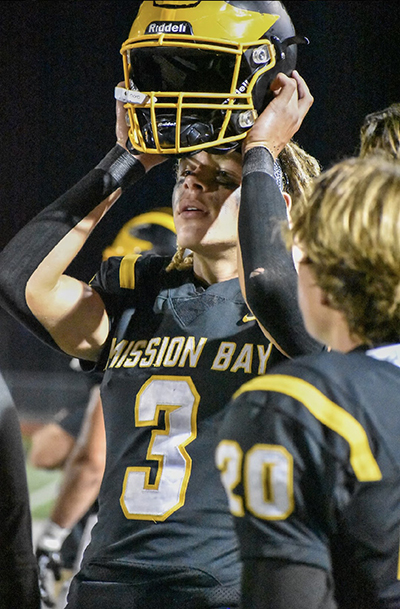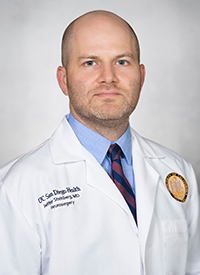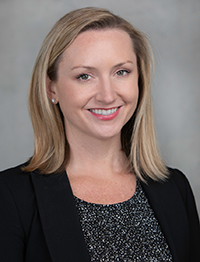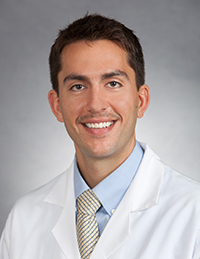Unexpected Impact: Concussion Derails Football Dreams, Experts Help Ignite Hurdles Talent
Concussion clinic at UC San Diego Health played an integral role in Caden Taffe’s return to sport
Story by:
Published Date
Story by:
Topics covered:
Share This:
Article Content
Ask Caden Taffe if he ever imagined he’d be sprinting over hurdles to break multiple school track records, and he’ll say the only place he dreamed of running toward was the end zone — on the football field.
But when a traumatic brain injury (TBI) sidelined his football aspirations last year, the 17-year-old discovered he had another talent to hone on the track. Heading into his senior year at Mission Bay High School, the road to recovery has included challenges and setbacks he’d prefer to leave in the rearview mirror. Yet sometimes talents have a unique way of revealing themselves in unexpected ways.
“I don’t know if there’s anything I love as much as football. So, when I learned I wasn’t going to be able to play again, that was the worst,” Taffe remembers. “But what I’ve gone through has created this new focus on hurdles and on refining my technique. Track wasn’t a replacement for football — it was more of a distraction — but it has helped me focus my athleticism into something else I can excel at.”
Unthinkable outcome
It was Sept. 15, 2023, when Taffe stepped onto the football field to line up against his school’s rival. It was a big game, and Taffe started as an offensive running back. Not long into the game, he dislocated his finger, but was able to pop it back into place and continue playing. He then took another significant hit during a tackle, but nothing seemed out of the ordinary, so he stayed in the game.
“A couple plays after that hit, my feet just literally slipped out from under me,” Taffe recalls with a wave of emotion. “I couldn’t keep my balance. I knew I should not be playing, so I sat on the sidelines for the rest of the game.”

Taffe’s mom, Kristen Jepsen, watched in horror from the stands as their team’s athletic trainer motioned for her to come down to the field.
“I knew it was bad — he had taken a hard hit, and he took himself out of the game,” Jepsen recounts through tears. “Nobody wants to see a young, healthy kid get injured like that. It’s scary for everyone.”
The athletic trainer advised her to keep a close eye on her son throughout the night and to take him to the hospital if symptoms worsened. On the drive home from the game, Taffe remembers feeling nauseous and blinded by road and car lights. By the time he got home and tried taking a shower, his head was spinning and he was vomiting.
“That’s when we knew we had to take him to the emergency department — he was vomiting in the waiting room and screaming in pain,” remembers Jepsen — a mother’s worst nightmare.
Taffe was taken to a local hospital’s intensive care unit (ICU) where a computed tomography (CT) scan revealed a subdural hematoma.
“He hadn’t lost consciousness during the game, and he wasn’t showing symptoms right away, so we were shocked that he had a brain bleed,” Jepsen said.
Symptoms continued to escalate. Taffe remembers being so thirsty in his ICU room, yet unable to effectively say what he needed.
“He wanted a drink of water, but what he was saying was absolute gibberish because he had an episode of aphasia — it was so scary,” Jepsen remembered. Aphasia, caused by brain damage, is the loss of ability to understand or express speech.

After four days of pain management, monitoring brain swelling and taking neural exams, Taffe had improved enough for release from the ICU. But just a couple weeks later, and before his scheduled appointment with a neurologist, he woke up with intense pressure in his head, vomiting and shooting pain. On Oct. 8, 2023, his family took him to Hillcrest Medical Center at UC San Diego Health where a CT scan revealed that the subdural hematoma had not resolved and was likely associated with a pre-existing arachnoid cyst that had ruptured.
Jeffrey Steinberg, MD, associate professor of neurological surgery at University of California San Diego School of Medicine and neurosurgeon at UC San Diego Health, recommended urgent surgery for decompression of the brain, which the family scheduled for the next morning.
“The only thing I remember thinking was that I hope the surgery will stop my headache — it was really bad — a 10 out of 10,” Taffe said. To the family’s relief, the craniotomy and arachnoid cyst removal were a success. “After the surgery, I felt so much better immediately. It really was a freak accident because I already had this cyst — we just didn’t know about it. And I got hit at the wrong angle with the wrong pressure and that caused the cyst to burst, which is rare.”
Consequences of youth concussions
As many as 3.8 million concussions occur each year in the United States from sports-related injuries according to the Center for Disease Control and Prevention (CDC). Approximately 300,000 of those are from football. The CDC estimates that two in 10 high school athletes who play contact sports — including soccer and lacrosse — will suffer a concussion this year and that five in 10 concussions will go unreported or undetected.
High school and middle school athletes are more susceptible to sports-related concussions than adults due to greater participation in contact sports, larger head-to-body size ratio, weaker neck muscles, increased risk of posttraumatic seizures and age-specific differences in cerebral blood flow and metabolism in the developing brain.

According to the CDC, the incidence of sport-related concussions has been escalating in a variety of sports, and its impact on long-term cognitive function is increasingly recognized. Concussions are associated with an increased risk of neurological diseases and long-term cognitive deficits. Additionally, athletes who continue to play while having concussion symptoms or who return to play while the brain is still healing, have a greater chance of suffering another concussion and having prolonged recovery and/or persistent post-concussive symptoms.
“No two concussions are alike in terms of their symptoms and what we may expect afterwards,” said Amanda Gooding, PhD, associate professor of psychiatry at UC San Diego School of Medicine and neuropsychologist at UC San Diego Health. “What really needs to be the focus is educating the public, parents, coaches and leagues about the identification of injuries and proper management during the acute phases so that we can more appropriately plan for the long-term recovery.”
That focus on long-term recovery was the primary reason Jepsen turned to the concussion clinic at UC San Diego Health for a comprehensive evaluation and a customized plan of care for her son’s rehabilitation after the TBI.
UC San Diego Health offers extensive concussion testing and treatment options for athletes with a suspected concussion where comprehensive diagnostics and treatment occur following a head injury to ensure athletes can return to sport safely. Baseline testing is also offered for individual athletes or teams before their season begins to have metrics to compare to, should a head injury occur. Concussion team doctors at UC San Diego Health are trained in sports medicine, rehabilitation, neurology, neurosurgery and neuropsychiatry, offering a holistic approach to diagnosing and treating head injuries.
Using industry-standard tests, a sports medicine physician, staff athletic trainer and physical therapist assess symptoms such as orientation, memory, concentration, balance, neurocognition and vestibular status. The concussion clinic also features ImPACT concussion testing, a scientifically validated, research-based computer test that helps evaluate recovery following a head injury. ImPACT is used by the NFL, NHL, MLB and NASCAR.
Any head injury is best assessed by an experienced professional, particularly since concussion symptoms may not appear until after the initial impact. An untreated concussion or an athlete who returns to play too soon can result in prolonged recovery and/or persistent post-concussive symptoms.
“Caden was a shell of himself, physically, but he just never gave up,” Jepsen recalled. “At the concussion clinic, they really want athletes to get back to their original level of excellence, which I know was very important for Caden. Those visits were helpful because the care team knew what his goals were and how much he wanted to get back to sports and they helped him achieve that.”
Road to recovery
As Taffe began his recovery from brain surgery at home, the thought of spending the next six weeks doing very little, as advised by his medical team, seemed daunting.

“I was sick and tired of sitting home and not doing anything, which was a huge 180 from going to football practice every day,” Taffe remembered. “Sport was such a huge part of my life and then it was just gone.”
Taffe’s overwhelming feeling of loss for physical activity is a common theme in the concussion clinic, according to the clinic’s director, Alan Shahtaji, DO, professor of family medicine and public health at UC San Diego School of Medicine, and primary care physician and sports medicine specialist at UC San Diego Health. Shahtaji and his team got to work on creating a recovery plan that would give Taffe hope.
“We don’t focus on what the athlete can’t do, but instead on what they can do,” Shahtaji said. “With athletes like Caden, sport is part of their DNA. So, it’s important to do a holistic assessment to determine what is needed including lifestyle modifications, setting expectations and goals. We implement personalized strategies to guide them through their recovery and help them return safely to physical activity.”
The concussion clinic also played an integral role in mapping out a modified learning plan that would allow him to return to school gradually as he healed.
“He had missed six weeks of school and needed a reduced workload when he returned because with his mental capacity after all of this, he could only handle so much,” Jepsen said. “His doctors helped us navigate accommodations at school and to deal with the overstimulation and exhaustion of going back to school.”
“They come at the problem from all angles and don’t make athletes feel like they just have to accept this as the new normal. They provide confidence and hope throughout the process.”
After getting post-operative clearance from Steinberg and his team, Taffe got the green light to return to the gym to work on his strength. He was elated and ready to get back in shape after having lost 25 pounds in six weeks since the accident, dropping from 185 to 160. Although he knew returning to football was off the table due to the severity of his TBI, he set his sights on getting strong and gaining his weight back for track season, which began in March 2024.
He got the all-clear from his doctors to train for track just before the season began.
“They were very supportive of me pursuing hurdles because there is no physical contact with other athletes. So that helped me to know the doctors were in full support of me going full force to see what I could do,” Taffe said. “I originally got into track before my concussion to get faster and stronger for football, but it turns out, I’m actually really good at it.”
Looking ahead
Taffe admits that hurdles will never replace football, and that he’s “not sure I’ve completely grasped that I can’t play anymore.”
Yet his unexpected talent in hurdles quickly surfaced this year. Taffe had turned out for the track team in 2023 when his football coach advised that training for track can heighten speed and strength on the football field.
With hurdles now his primary focus, Taffe recently qualified to compete in the San Diego California Interscholastic Federation (CIF) meet in May, where he placed fifth in the 100-meter hurdles and seventh in the 300-meter hurdles in San Diego County, just nine months after his concussion and neurosurgery. He currently holds school records for both.
“Caden has overcome so much — he seemed to recover faster than I did,” his mom said with a chuckle. “All of this has been really hard on him because he still wishes he was playing football, yet he still has that competitive spirit and drive to set new records for his school. But he had to change the goals he was working toward.”
Taffe said he’ll never give up on football. That’s why he’s currently working as a coaching assistant for Mission Bay High School’s football team.
“Just being out there, working with the coaches and the younger guys who are coming in, that’s fun,” Taffe said. “It’s hard watching other people be able to play, but since I can’t play, it’s better to be out there in some way than not at all. I still get to be around the football culture, my friends and the team.”
That optimistic attitude is what Shahtaji said has helped set Taffe up for success. In addition to track, he carved his way down the slopes at Mammoth Mountain on his snowboard at the end of this year’s ski season, has returned to surfing regularly and is looking forward to testing out his skills on the beach volleyball court.
“He really has found other things that have given him joy and allow him to stay physically active while avoiding the higher-risk head injury activities,” Shahtaji said. “He’s showed a lot of maturity, grit and perseverance and has had a pretty persistently positive attitude about the whole situation.”
Spotlight on safety
With the continued prevalence of concussions in contact sports, increased awareness and education about identifying and treating concussions is paramount, according to Gooding.
“I do think the culture of contact sports is changing, but I still think that we have a long way to go to instill a culture of safety in sports,” Gooding said. “There are many efforts underway to make games safer, to reduce contact in practices and to educate players about safer tackling, yet there are more safety protocols that need to be incorporated into contact sports — especially for youth.”
Jepsen advocates for local school districts to require baseline concussion testing for youth impact sports. Baseline testing establishes a player’s typical responses to balance, memory and cognition. The testing is completed before the season begins, so that if a head injury occurs, health experts can evaluate an athlete’s current condition with the baseline test results.
“Sometimes we don’t even know when a concussion has happened, so that’s where the baseline test comes in,” Jepsen said. “After an injury, you would go back and compare and see just how much you’ve lost. And sometimes — like in Caden’s situation — you just have to call it. Because it’s not worth ruining your life for a high school football game.”
However, Taffe is quick to admit that, “If I got the all-clear to play football again, I’d be out there tomorrow.”
Yet his circumstances have unveiled a talent in running hurdles that he may not have discovered.
“If this hadn’t happened, I may not have gotten this far in hurdles or become so immersed in it. I might not have cared as much about it,” Taffe said frankly. “But if I had it all to do over again, I wouldn’t have done anything differently — I just had a freak accident. I’m still very much in the pro football camp.”
Topics covered:
Share This:
You May Also Like
Stay in the Know
Keep up with all the latest from UC San Diego. Subscribe to the newsletter today.




